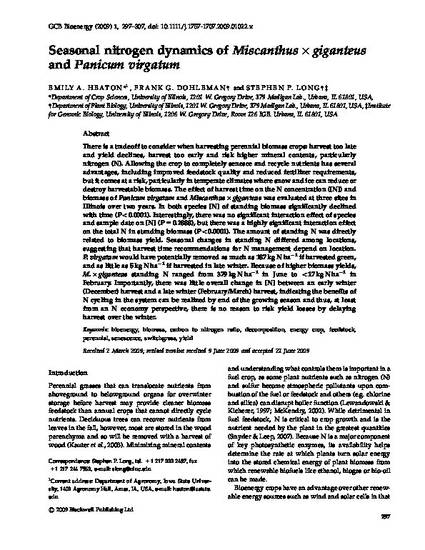
Article
Seasonal nitrogen dynamics of Miscanthus×giganteus and Panicum virgatum
GCB Bioenergy
(2009)
Abstract
There is a tradeoff to consider when harvesting perennial biomass crops: harvest too late and yield declines, harvest too early and risk higher mineral contents, particularly nitrogen (N). Allowing the crop to completely senesce and recycle nutrients has several advantages, including improved feedstock quality and reduced fertilizer requirements, but it comes at a risk, particularly in temperate climates where snow and ice can reduce or destroy harvestable biomass. The effect of harvest time on the N concentration ([N]) and biomass of Panicum virgatum and Miscanthus×giganteus was evaluated at three sites in Illinois over two years. In both species [N] of standing biomass significantly declined with time (P<0.0001). Interestingly, there was no significant interaction effect of species and sample date on [N] (P=0.2888), but there was a highly significant interaction effect on the total N in standing biomass (P<0.0001). The amount of standing N was directly related to biomass yield. Seasonal changes in standing N differed among locations, suggesting that harvest time recommendations for N management depend on location. P. virgatum would have potentially removed as much as 187 kg N ha−1 if harvested green, and as little as 5 kg N ha−1 if harvested in late winter. Because of higher biomass yields, M. ×giganteus standing N ranged from 379 kg N ha−1 in June to <17 kg N ha−1 in February. Importantly, there was little overall change in [N] between an early winter (December) harvest and a late winter (February/March) harvest, indicating the benefits of N cycling in the system can be realized by end of the growing season and thus, at least from an N economy perspective, there is no reason to risk yield losses by delaying harvest over the winter.
Keywords
- bioenergy,
- biomass,
- carbon to nitrogen ratio,
- decomposition,
- energy crop,
- feedstock,
- perennial,
- senescence,
- switchgrass,
- yield
Disciplines
Publication Date
August, 2009
DOI
10.1111/j.1757-1707.2009.01022.x
Publisher Statement
This article is published as Heaton, Emily A., Frank G. Dohleman, and Stephen P. Long. "Seasonal nitrogen dynamics of Miscanthus× giganteus and Panicum virgatum." Gcb Bioenergy 1, no. 4 (2009): 297-307. doi: 10.1111/j.1757-1707.2009.01022.x. Posted with permission.
Citation Information
Emily A. Heaton, Frank G Dohleman and Stephen P Long. "Seasonal nitrogen dynamics of Miscanthus×giganteus and Panicum virgatum" GCB Bioenergy Vol. 1 Iss. 4 (2009) p. 297 - 307 Available at: http://works.bepress.com/emily-heaton/37/
Creative Commons license

This work is licensed under a Creative Commons CC_BY-NC International License.
